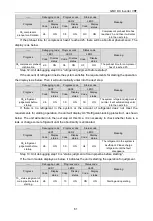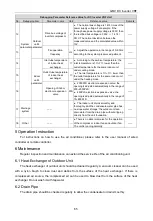
GMV DC Inverter VRF
53
Check Items
Conditions Might Happen
Check
Does the unit drain well?
It may cause condensation and dripping.
Is the voltage in accordance with the rated voltage
specified on the nameplate?
It may cause malfunction or damage the part.
Is the electric wiring and pipe connection installed
correctly and securely?
It may cause malfunction or damage the part.
Has the unit been earthed securely?
It may cause electrical leakage.
Is the power cord specified?
It may cause malfunction or damage the part.
Has the inlet and outlet been blocked?
It may cause insufficient cooling/heating
capacity.
Has the pipe length and refrigerant charging
amount been recorded?
The refrigerant charging amount is not
accurate.
Is the address code of outdoor modules correct?
The unit can't run normally. Communication
malfunction might happen.
Is the address code of indoor units and wired
controller correct?
The unit can't run normally. Communication
malfunction might happen.
Has the communication line been connected
correctly?
The unit can't run normally. Communication
malfunction might happen.
Is the pipe connection and valve status right?
The unit can't run normally.
Whether phase sequence of external power cord is
correct or not?
Operation fault occurs or unit is damaged.
The above inspection items after installation are the inspection for some key components.
Please conduct the check according to actual needs.
4 Debugging and Operation
NOTES!
(1) Do set one (only one) module as the main module during debugging.
(2) When there is no special requirement, the other functions do not need to be set, and it can
be operated according to the factory settings. For special functions, please refer to the
related technical documents.
(3) Button description: short press: press the button for 3s and then release it; hold the button
for 5s: press the button for 5-10s and then release it; hold the button for 10s: press the
button for 10s and then release it.
4.1 Preparation before Test Run
(1) Installation and debugging operation must comply with the relevant regulations of the local
country or region.
(2) Debugging must be carried out by a professional or under the guidance of a professional. Do
not debug the air conditioning unit by yourself.
(3) All scattered objects, especially metal chips, wire ends and clamps, should be removed from
the body.
(4) Check if the terminals of the electrical components in the unit are loose and the phase
sequence is correct.
(5) Before debugging, all pipeline valves of the unit are required to be open.
(6) Power cannot be supplied until all installation work is completed.
















































